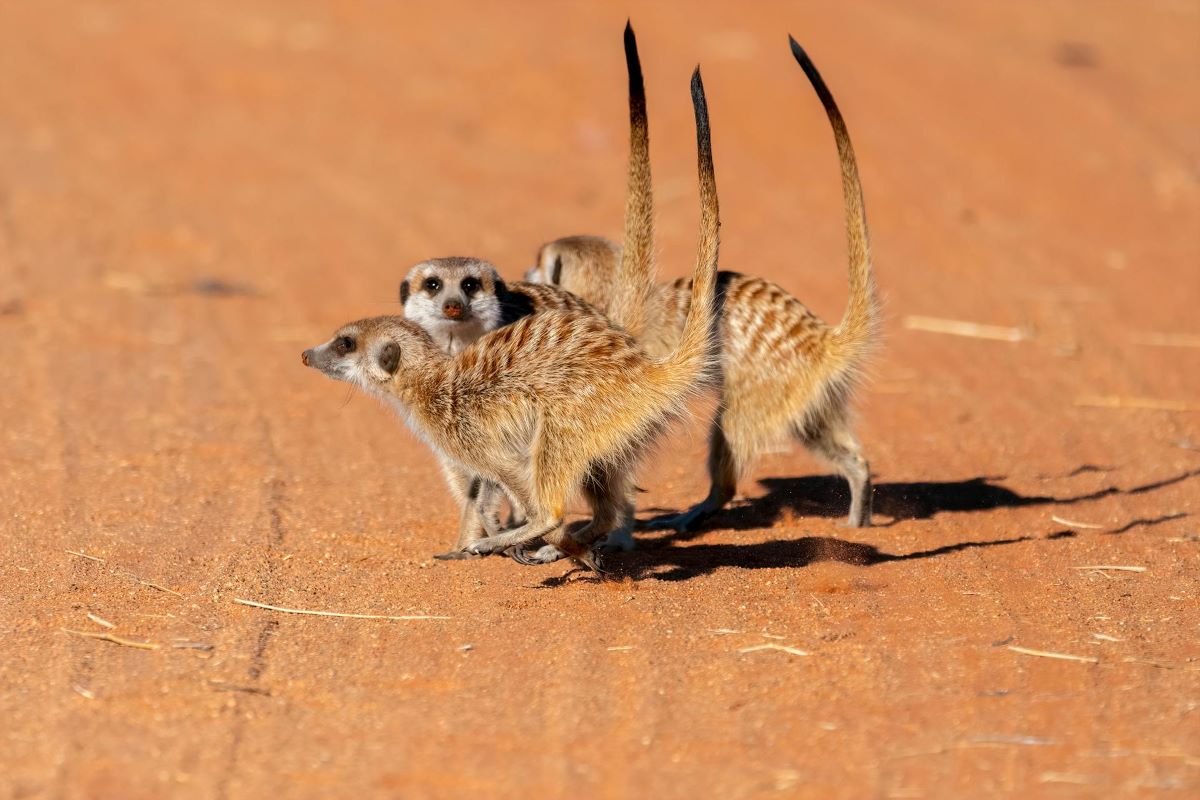While many hunters tend to gravitate towards Africa’s famous Big 5 animals, another group known as the “Shy 5” will also pique a hunter’s interest. Yes, they may not be the largest, most aggressive, or most dangerous to encounter on an African hunting safari; but still, these creatures tick all the boxes for an interesting, challenging, and exciting African hunt.
[DYNAMIC-BLOGTABLEOFCONTENT]
What is the Shy 5?
The Shy 5 is a set of rarely seen animals. Consisting of the meerkat, aardwolf, aardvark, porcupine, and bat-eared fox, this group of elusive animals are rarely spotted and are experts in the art of disguise. Should they indeed be spotted, they are quick to retreat, and with four of the five animals being nocturnal, it does make them more of a challenge to see during an African hunting adventure. From the group, only the meerkat is active during daylight hours, adding more excitement to your game hunting safari, as night hunts come into play!
Targeting the Shy 5 on an African Hunting Safari
While some hunters may be solely focused on Africa’s Big 5, the Small 5, or even the Ugly 5 during an African hunting safari, this grouping of shy animals provides the ultimate test for hunters wanting a unique game hunting safari to test their skills, patience, and endurance. While most use the cover of darkness to help them evade predators, they are also masters of elusive, secretive, and evasive behavior.
Each member of the Shy 5 is also an unusual-looking trophy, ensuring memorable and unique game hunting trophies to look back upon. From snouts and quills, to huge ears and solid tails, this group is an interesting group of animals to target on an African hunting adventure.
The Meerkat
The meerkat (Suricata suricatta), also known as the Suricate, is a tiny mammal inhabiting the drier regions of southern Africa. It is found in South Africa, Namibia, Botswana, as well as in a small section of Angola. The aforementioned areas provide the perfect habitat for the meerkat, as it prefers semi-arid or arid regions and inhabits grasslands, savanna-type regions as well as deserts.
While they weigh less than 2 pounds, these spunky little mammals are known for their bravery, energy, and stamina in the face of danger. This is clearly seen at times when, for example, they band together to attack a common enemy, such as a venomous snake that threatens the safety of the group. These feisty little creatures continuously attack the snake from all sides, wearing it down and killing it before it can enjoy a tasty meerkat snack.
Meerkats are social animals and live in troops that range between 5 and 40 members. They are rarely more than 15 feet from each other. The problem with targeting these mammals – and part of the reason why they are members of the Shy 5 – is getting close enough to actually shoot the elusive meerkat.
Of all the members of the Shy 5, the meerkat is probably the easiest to spot, firstly because they are out during the day and secondly, they are often spotted standing on their hind legs, serving as a lone sentry keeping watch over their troop. They are constantly scanning the horizon, on high alert for any sign of danger or something unusual. This will have them calling the rest of the troop, resulting in a mad dash to the safety of the underground burrow.
Perhaps the word “burrow” is a bit of an understatement here, as a burrow tends to make a person think of a single, basic, underground hole. Meerkats actually reside in a series of burrows that are connected with tunnels and a few of these exist within their home range of around 1.9 miles. These burrows and tunnels can reach up to 16 feet in width, and 5 feet in depth, and sport 2-3 levels – more like a burrow mansion! With so many tunnels connecting the burrows, it is no wonder that they can escape so easily!
Meerkats are often considered a trophy of opportunity, where the hunter just happens to be in the right place at the right time to target this elusive creature. They are often spotted from a vehicle while on the lookout for other hunting trophies, or the hunting party comes across them while on a walk-and-stalk.
As this target on this African hunt is so petite, weighing between 1.4-2 pounds, a suggested rifle would be a shotgun with bird hunting ammo, or even a .22. You don’t want to ruin this specialty game hunting trophy.
The IUCN has listed the meerkat with a status of “least concern” and this unusual African safari hunting trophy will be a talking point for many years to come.
Interesting Facts about Meerkats
- They have excellent eyesight
- They are immune to certain types of venom
- They don’t drink water but rather get all the fluids they need from the animals and plants they consume

The Aardvark
The aardvark (Oryteropus afer) is a large mammal with a thick neck, an elongated pig-type snout, and long tubular ears, with gray coloring. It has an arched back, short, stocky legs, and a long, solid tail. The aardvark prefers a habitat of open woodlands, grasslands, scrub, and even forests, but is not fond of desert-like regions. It is found throughout most of the African continent, south of the Sahara desert.
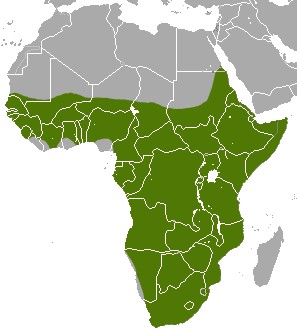
This termite-eating digging machine is mostly nocturnal, resting and sleeping during the day, but there are instances where an aardvark will also forage during the day, depending on conditions. It uses its strong, thick claws on its front legs to dig up and destroy termite nests and anthills to reach its meal, eagerly consuming it with their long, sticky 12-inch tongue before heading out to the next termite nest or anthill. Their digging skills are well known within the hunting world, and in only 15 seconds they can dig up to 3 feet! It is no wonder then that they are notorious for digging burrows and escaping into them, leaving predators like hyenas and lions staring hungrily into a deep hole.
Aardvarks are hunted at night, under spotlights. Aardvarks aren’t the largest of animals, weighing around 110-180 pounds as a mature adult, and caution should be taken when targeting them on an African hunt to ensure your weapon choice is correct. Suggested rifles would be a .22 or a .243, and even a shotgun. If only larger caliber rifles such as a .308 Winchester Magnum, 30-06 Springfield, or 300 PRC are available, consider using monolithic bullets.
Invest in a good quality scope for the aardvark hunting adventure and be comfortable using it. The use of a thicker reticle will allow for quick target acquisition and shooting in low-light conditions, or with the use of artificial light as utilized on a nocturnal aardvark hunting safari.
Aardvark hunting in Africa is something that needs to be experienced firsthand! While aardvarks may not have good eyesight, both their senses of hearing and smell are exceptional, and together with their notorious fast escapes, make them a worthy adversary for any hunting enthusiast.
The aardvark is listed with a status of “least concern” by the IUCN, although its numbers are decreasing.
Interesting Facts about Aardvarks
- They are solitary animals
- Even though their name, when translated from Afrikaans, means “earth pig” they are not pigs
- They have an excellent sense of smell
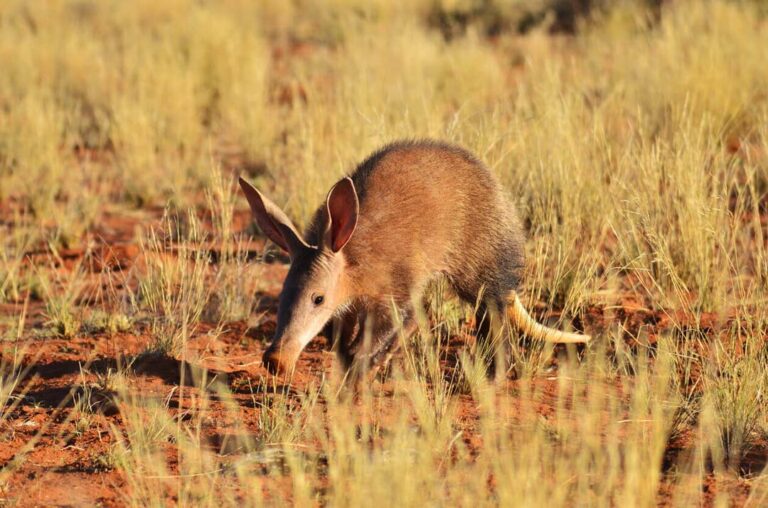
The Aardwolf
The aardwolf (Proteles cristatus) is a nocturnal, termite-eating mammal that research has shown is, in fact, a hyena!
Aardwolves are striking animals, sporting a yellowish coat with distinctive vertical black stripes and a bushy, black-tipped tail. Generally topping the scales at around 15-22 pounds, the aardwolf resembles a very thin hyena. It has a long, distinctive mane running down the neck and back’s midline, with one or two diagonal stripes down the fore- and hindquarters, along with several stripes on its legs.
There are two distinctly separate populations of aardwolves:
- The first population is active and thriving across southern Africa.
- The second population is found along Africa’s east coast and northeastern Africa.
Their location depends largely on finding sufficient harvester termites to forage and they prefer habitats that include dry plains, shrubs, and bushland, while largely avoiding mountainous regions.
This specialty animal is generally hunted under spotlights, with different regions and countries having different regulations, for example, a permit is required to hunt aardwolves in South Africa. Night hunting, apart from being an extremely exciting and adrenaline-filled activity, also requires patience and tenacity. The aardwolf is not part of the Shy 5 without reason and is renowned for its elusive, shy, and secretive nature that all assists in making this a challenging African hunt.
When aardwolf hunting in Africa and considering rifles for the hunting safari, a suggestion would be a low-caliber rifle loaded with a solid bullet. As the hunt will take place at night, fit the rifle with good options, to allow for low lighting conditions in the field.
The aardwolf is listed as “least concern” by the IUCN. Many believe that there are more of this species than some may have reckoned upon and that the aardwolf’s elusive, secretive nature, along with its ability to hide well, is masking its true numbers.
Interesting Facts about Aardwolves
- They can consume up to 300,000 termites per night
- Aardwolves are monogamous
- Aardwolf means “earth wolf”
- Although they can dig their own burrows, they often use abandoned burrows to shelter in
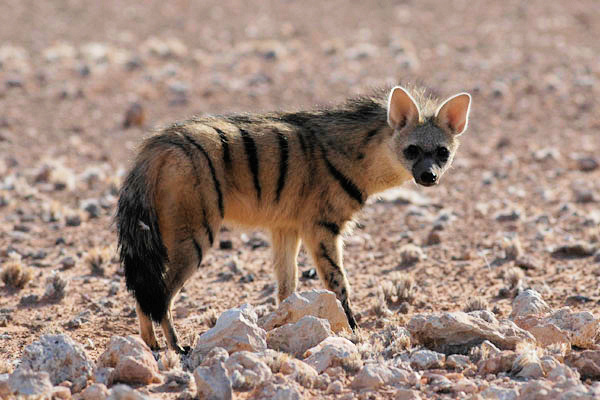
The Porcupine
Africa is home to three different species of porcupines:
- Cape porcupine (Hystrix africaeaustralis)
- North African porcupine (Hystrix cristata)
- African Brush-tailed porcupine (Atherurus africanus)
The Cape porcupine and the North African porcupine are quite similar in appearance, with large black-and-white banded quills, while the African bush-tailed porcupine is smaller with short white quills at the tip of its tail. Its body quills are also quite short.
Porcupines are a sought-after game hunting trophy, simply because they are so unusual and rare. While on your African hunt and you come across a porcupine, consider yourself extremely lucky and take that shot! It is a rate reward to encounter this nocturnal creature and many hunts are purely opportunistic while searching for other prey.
If specifically hunting porcupines, this will happen at night, using spotlights. When it comes to porcupine hunting in Africa, use a rifle with which you are familiar and that you are comfortable shooting. Believe it or not, porcupines are quite difficult to kill, with tough torsos. Depending on the distance from the porcupine, a shotgun loaded with bird shot can be used, alternatively, a .22 caliber will also work well.
All three species of porcupines are listed by the IUCN with a status of “least concern.”
Interesting Facts about Porcupines
- They are good swimmers
- They can climb trees in search of food and sometimes even nest in trees
- They are covered in more than 30,000 quills
- Their quills are hollow and light

The Bat-eared Fox
The bat-eared fox (Otocyon megalotis) is a small fox living in two main areas of the African continent in two distinct populations in southern and east Africa respectively.
Their chosen habitat includes grasslands, savannas, woodlands, and acacia woodland areas. They prefer regions with shorter grasses or minimal vegetation which allows them to easily hunt, with prey primarily including termites and dung beetles. Should they, however, feel threatened, they will seek out the taller grassy areas in which to hide and camouflage themselves.
When targeting the bat-eared fox on an African hunt, there are two main hunting methods utilized. Firstly, many times hunters come across them while on the lookout for other game, allowing an opportunistic hunting adventure to fall into their laps. Alternatively, it can also be hunted at night, under a spotlight, or even called closer using a predator call.
These game hunting targets are agile, quick, and experts at the art of camouflage and hide-and-seek and half the challenge of this African hunt is actually finding your prey! A hint for the hunter is to be on constant alert, as these nimble foxes disappear again as quickly as they appeared in the first place!
Your hunting safari will require a small to medium-caliber rifle that can be used to hunt during the day or at night. A suggestion would be to use solid bullets and aim for the center of the animal’s chest.
It is classified as a species of “least concern” by the IUCN, making it a viable target for African hunts.
Interesting Facts about Bat-eared Foxes
- They are extremely fast runners, reaching speeds of 70 miles per hour
- Along with incredible speeds, they have excellent dodging ability and can change direction without really reducing speed
- They have incredible hearing
- Their favorite foods are dung beetles and termites
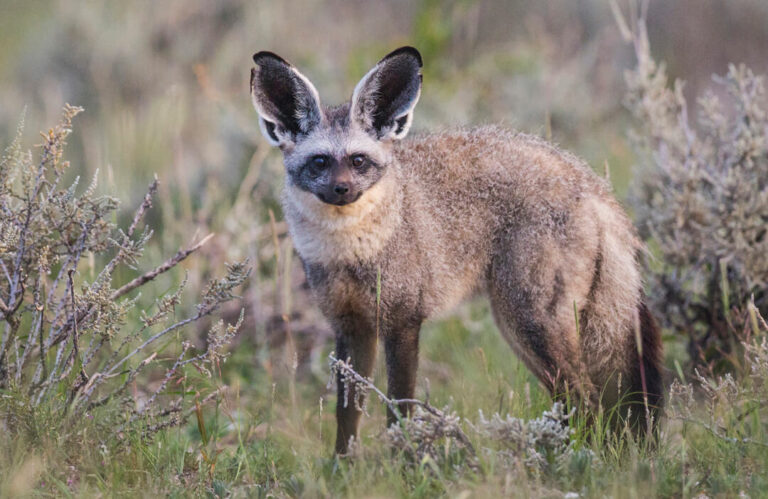
Worthy Adversaries on an African Hunting Adventure
The Shy 5 may be a different hunting safari than the usual trip when hunting in Africa but provides hunters with the opportunity to test their skills, patience, and tenacity against a group of animals that will require all these and more to harvest.
These animals’ ability to hide, camouflage, and protect themselves in the wild shows us how well-adapted nature is, with animals adapting to conditions, predators, and food supplies as and when needed.
Are you ready to take on the challenge of hunting Africa’s Shy 5 on an African hunting safari?
Author: B. Hershensohnn
